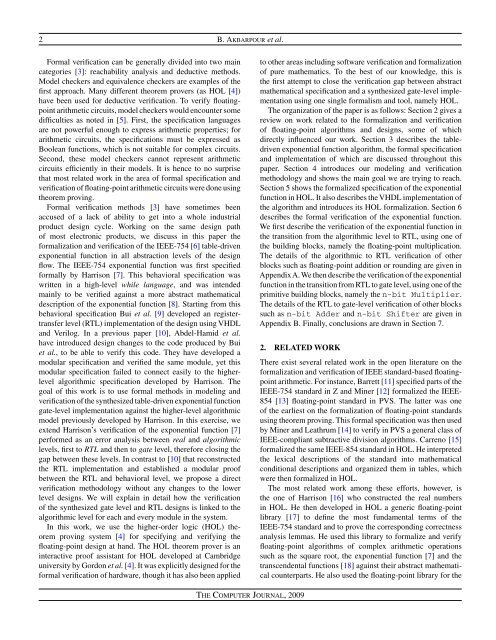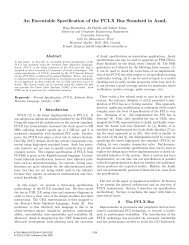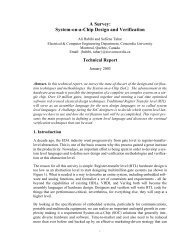Verifying a Synthesized Implementation of IEEE-754 Floating-Point ...
Verifying a Synthesized Implementation of IEEE-754 Floating-Point ...
Verifying a Synthesized Implementation of IEEE-754 Floating-Point ...
- No tags were found...
Create successful ePaper yourself
Turn your PDF publications into a flip-book with our unique Google optimized e-Paper software.
2 B. Akbarpour et al.Formal verification can be generally divided into two maincategories [3]: reachability analysis and deductive methods.Model checkers and equivalence checkers are examples <strong>of</strong> thefirst approach. Many different theorem provers (as HOL [4])have been used for deductive verification. To verify floatingpointarithmetic circuits, model checkers would encounter somedifficulties as noted in [5]. First, the specification languagesare not powerful enough to express arithmetic properties; forarithmetic circuits, the specifications must be expressed asBoolean functions, which is not suitable for complex circuits.Second, these model checkers cannot represent arithmeticcircuits efficiently in their models. It is hence to no surprisethat most related work in the area <strong>of</strong> formal specification andverification <strong>of</strong> floating-point arithmetic circuits were done usingtheorem proving.Formal verification methods [3] have sometimes beenaccused <strong>of</strong> a lack <strong>of</strong> ability to get into a whole industrialproduct design cycle. Working on the same design path<strong>of</strong> most electronic products, we discuss in this paper theformalization and verification <strong>of</strong> the <strong>IEEE</strong>-<strong>754</strong> [6] table-drivenexponential function in all abstraction levels <strong>of</strong> the designflow. The <strong>IEEE</strong>-<strong>754</strong> exponential function was first specifiedformally by Harrison [7]. This behavioral specification waswritten in a high-level while language, and was intendedmainly to be verified against a more abstract mathematicaldescription <strong>of</strong> the exponential function [8]. Starting from thisbehavioral specification Bui et al. [9] developed an registertransferlevel (RTL) implementation <strong>of</strong> the design using VHDLand Verilog. In a previous paper [10], Abdel-Hamid et al.have introduced design changes to the code produced by Buiet al., to be able to verify this code. They have developed amodular specification and verified the same module, yet thismodular specification failed to connect easily to the higherlevelalgorithmic specification developed by Harrison. Thegoal <strong>of</strong> this work is to use formal methods in modeling andverification <strong>of</strong> the synthesized table-driven exponential functiongate-level implementation against the higher-level algorithmicmodel previously developed by Harrison. In this exercise, weextend Harrison’s verification <strong>of</strong> the exponential function [7]performed as an error analysis between real and algorithmiclevels, first to RTL and then to gate level, therefore closing thegap between these levels. In contrast to [10] that reconstructedthe RTL implementation and established a modular pro<strong>of</strong>between the RTL and behavioral level, we propose a directverification methodology without any changes to the lowerlevel designs. We will explain in detail how the verification<strong>of</strong> the synthesized gate level and RTL designs is linked to thealgorithmic level for each and every module in the system.In this work, we use the higher-order logic (HOL) theoremproving system [4] for specifying and verifying thefloating-point design at hand. The HOL theorem prover is aninteractive pro<strong>of</strong> assistant for HOL developed at Cambridgeuniversity by Gordon et al. [4]. It was explicitly designed for theformal verification <strong>of</strong> hardware, though it has also been appliedto other areas including s<strong>of</strong>tware verification and formalization<strong>of</strong> pure mathematics. To the best <strong>of</strong> our knowledge, this isthe first attempt to close the verification gap between abstractmathematical specification and a synthesized gate-level implementationusing one single formalism and tool, namely HOL.The organization <strong>of</strong> the paper is as follows: Section 2 gives areview on work related to the formalization and verification<strong>of</strong> floating-point algorithms and designs, some <strong>of</strong> whichdirectly influenced our work. Section 3 describes the tabledrivenexponential function algorithm, the formal specificationand implementation <strong>of</strong> which are discussed throughout thispaper. Section 4 introduces our modeling and verificationmethodology and shows the main goal we are trying to reach.Section 5 shows the formalized specification <strong>of</strong> the exponentialfunction in HOL. It also describes theVHDL implementation <strong>of</strong>the algorithm and introduces its HOL formalization. Section 6describes the formal verification <strong>of</strong> the exponential function.We first describe the verification <strong>of</strong> the exponential function inthe transition from the algorithmic level to RTL, using one <strong>of</strong>the building blocks, namely the floating-point multiplication.The details <strong>of</strong> the algorithmic to RTL verification <strong>of</strong> otherblocks such as floating-point addition or rounding are given inAppendixA.We then describe the verification <strong>of</strong> the exponentialfunction in the transition from RTL to gate level, using one <strong>of</strong> theprimitive building blocks, namely the n-bit Multiplier.The details <strong>of</strong> the RTL to gate-level verification <strong>of</strong> other blockssuch as n-bit Adder and n-bit Shifter are given inAppendix B. Finally, conclusions are drawn in Section 7.2. RELATED WORKThere exist several related work in the open literature on theformalization and verification <strong>of</strong> <strong>IEEE</strong> standard-based floatingpointarithmetic. For instance, Barrett [11] specified parts <strong>of</strong> the<strong>IEEE</strong>-<strong>754</strong> standard in Z and Miner [12] formalized the <strong>IEEE</strong>-854 [13] floating-point standard in PVS. The latter was one<strong>of</strong> the earliest on the formalization <strong>of</strong> floating-point standardsusing theorem proving. This formal specification was then usedby Miner and Leathrum [14] to verify in PVS a general class <strong>of</strong><strong>IEEE</strong>-compliant subtractive division algorithms. Carreno [15]formalized the same <strong>IEEE</strong>-854 standard in HOL. He interpretedthe lexical descriptions <strong>of</strong> the standard into mathematicalconditional descriptions and organized them in tables, whichwere then formalized in HOL.The most related work among these efforts, however, isthe one <strong>of</strong> Harrison [16] who constructed the real numbersin HOL. He then developed in HOL a generic floating-pointlibrary [17] to define the most fundamental terms <strong>of</strong> the<strong>IEEE</strong>-<strong>754</strong> standard and to prove the corresponding correctnessanalysis lemmas. He used this library to formalize and verifyfloating-point algorithms <strong>of</strong> complex arithmetic operationssuch as the square root, the exponential function [7] and thetranscendental functions [18] against their abstract mathematicalcounterparts. He also used the floating-point library for theThe Computer Journal, 2009





